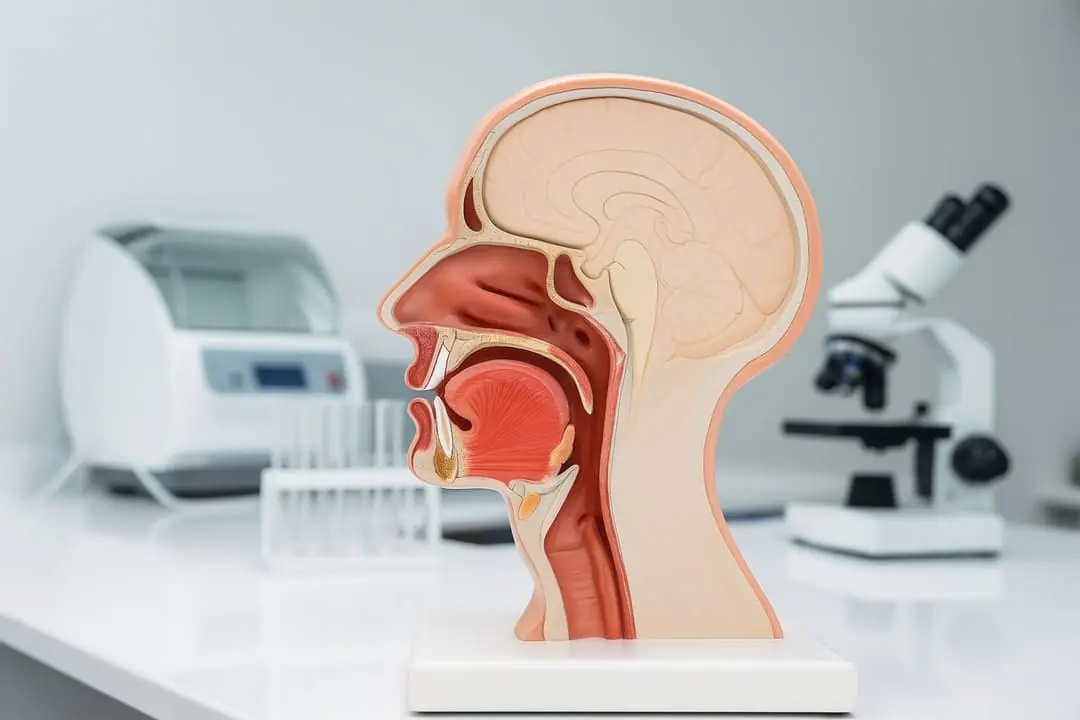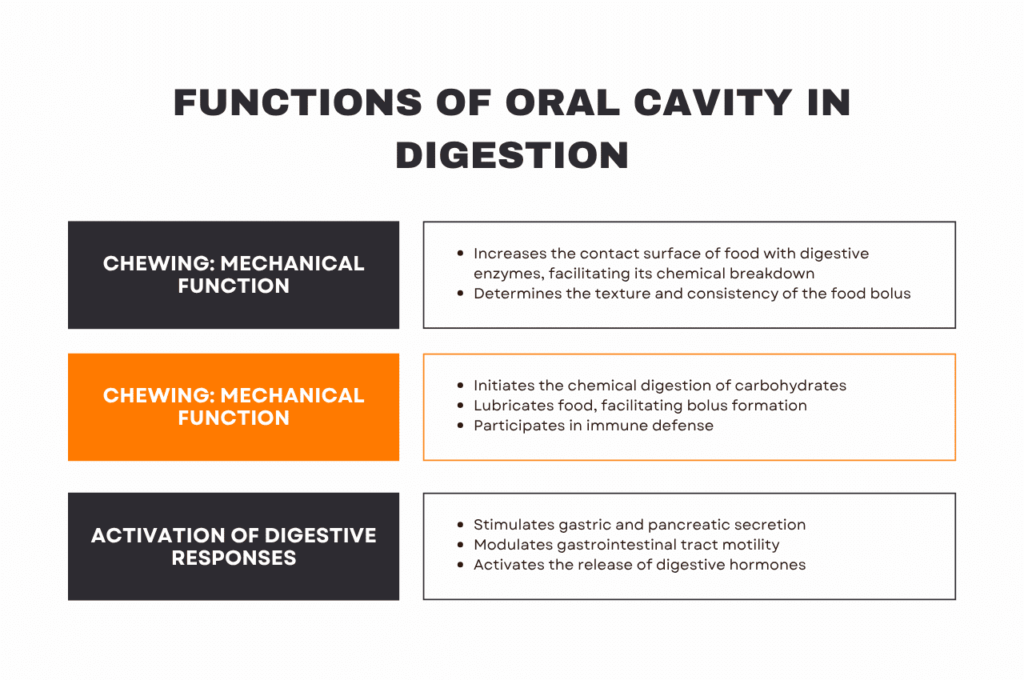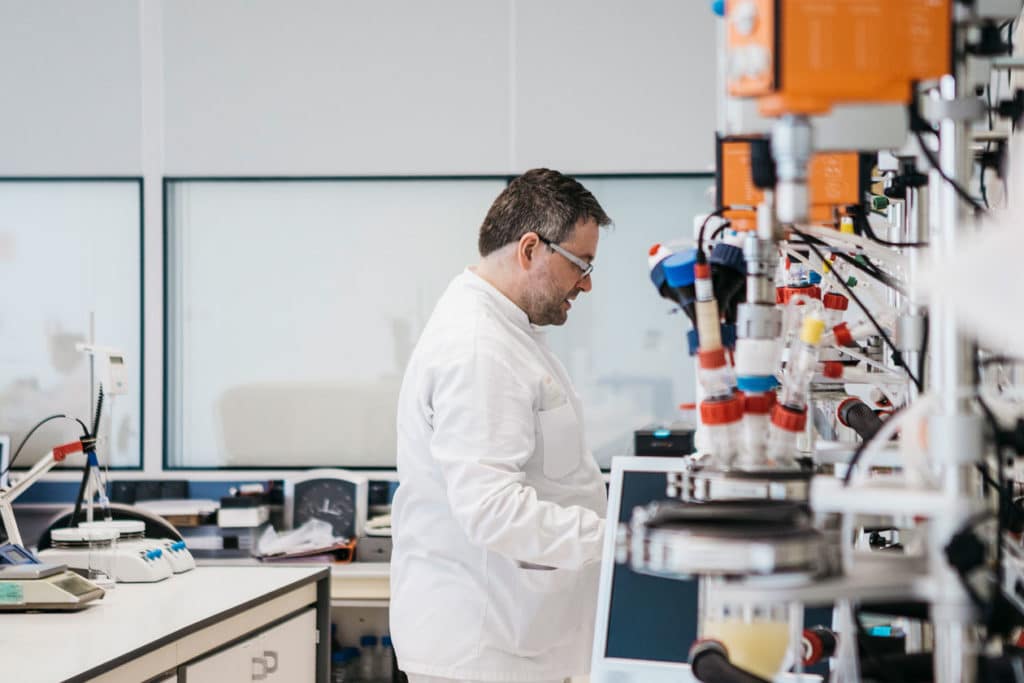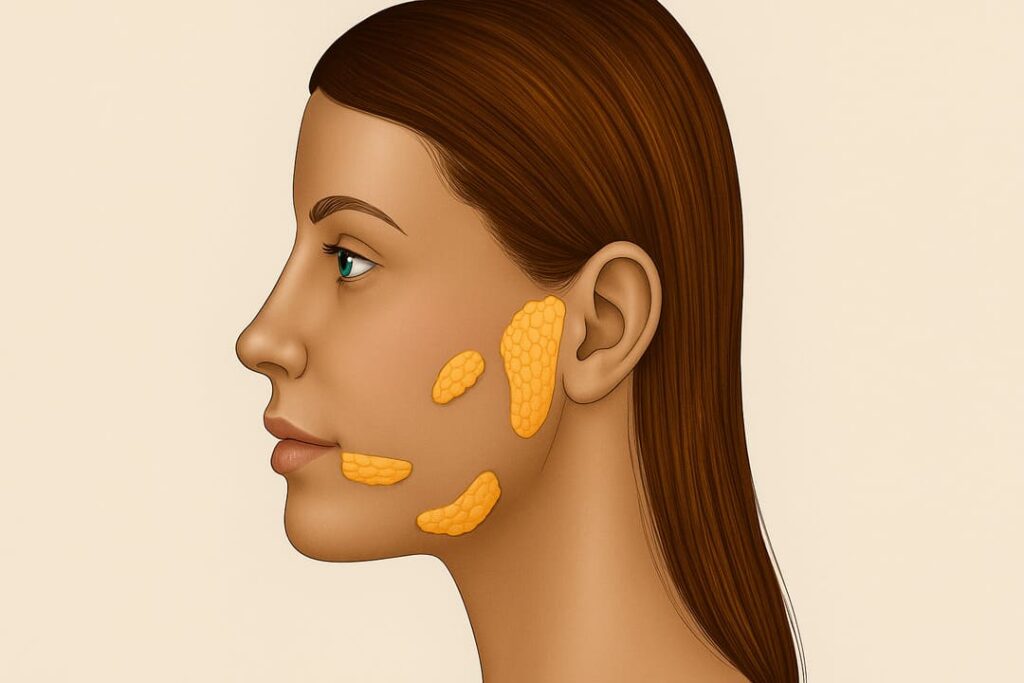Although often overlooked, the role of the oral cavity in the digestive system is fundamental. It is not only the first point of contact between the body and food, but also the site where the initial physical, chemical, and sensory mechanisms are activated.
From chewing to saliva secretion and oral microbiome activity, the mouth initiates a complex chain of events that directly influences digestion, nutrient absorption, and even intestinal health. The function of salivary glands, in particular, goes beyond simply hydrating and lubricating food—they also release key enzymes such as salivary amylase.
Furthermore, the eating experience is not limited to taste. The oral cavity is connected to other senses, such as smell, which plays an essential role in flavor perception through the phenomenon of retronasal olfaction. During chewing, volatile compounds from food reach the olfactory epithelium, stimulating sensory pathways that contribute to the pleasure of eating.
This sensory interaction activates complex neural circuits, including areas of the limbic system related to pleasure, reward, and emotional memory. In turn, these signals can influence the secretion of digestive hormones, anticipating the arrival of nutrients and preparing the digestive system for their processing.
Therefore, digestion begins long before food reaches the stomach. The mouth and senses play a key role in this early phase, not only physiologically, but also emotionally and sensorially.
Function of the Oral Cavity in the Digestive System
Digestion begins in the mouth, where the first physical and chemical mechanisms are activated to prepare food for its journey through the digestive system. This initial phase mainly involves two key processes: mastication and salivation.
- During mastication, the teeth break down food into smaller particles, increasing the surface area for digestive enzymes to act more effectively.
- At the same time, saliva, secreted by the salivary glands, hydrates and lubricates the food bolus, facilitating its passage through the pharynx and esophagus. But the function of salivary glands goes beyond mechanics: they release enzymes such as salivary amylase, which begins the digestion of carbohydrates even before the food reaches the stomach.
In addition, the oral cavity is the first biological environment where food comes into contact with the oral microbiome, a community of microorganisms that can influence the transformation and bioavailability of certain bioactive compounds, potentially impacting overall health and the intestinal microbiota.
In summary, this stage fulfills fundamental functions:
-
Mechanical: food fragmentation and bolus formation to facilitate swallowing.
-
Enzymatic: beginning of chemical digestion, especially of starches.
-
Sensory: perception of flavor, temperature, and texture, which stimulates appetite, modulates the eating experience, and triggers digestive responses through the gut-brain axis.
These early-stage processes not only affect the efficiency of digestion, but also the body’s metabolic, emotional, and sensory response to food. Understanding the function of the oral cavity in the digestive system therefore goes far beyond mechanics: it is a fundamental gateway to efficient digestion and conscious nutrition.
Mastication: Mechanical Function
Mastication is the first active step in the digestive process. The teeth, together with the masticatory muscles and the tongue, break food into smaller particles, significantly increasing the surface area exposed to digestive enzymes. This mechanical processing not only facilitates subsequent chemical breakdown but also allows detection of the food’s texture, temperature, and consistency, which influences sensory perception and prepares the body for digestion.
The effectiveness of mastication directly affects the formation of the food bolus, a homogeneous and lubricated mass that can be easily swallowed. Poor chewing can impair digestion later on, affecting gastric emptying rates and nutrient bioavailability.
Salivation: Chemical and Protective Function
At the same time, the salivary glands secrete saliva, a complex mixture that plays key roles in digestion, immunity, and homeostasis. Its composition includes water, mucins, electrolytes, digestive enzymes such as salivary amylase (ptyalin), and antimicrobial substances like lysozyme and lactoferrin.
The main functions of saliva in this stage are:
-
Initial chemical digestion: salivary amylase begins breaking down complex carbohydrates such as starch into simpler sugars.
-
Lubrication: mucins provide viscosity to the saliva, facilitating bolus cohesion and its passage through the pharynx and esophagus.
-
Immune defense: lysozyme, lactoferrin, and secretory IgA act as antimicrobial barriers, limiting the growth of pathogenic microorganisms in the oral cavity.
-
Dental enamel protection: by neutralizing acids and maintaining proper pH, saliva helps prevent cavities and supports oral homeostasis.
Far from being a mere preliminary stage, what happens in the mouth influences overall digestive efficiency, intestinal microbiota health, and the transformation of bioactive compounds.
To study these interactions more deeply, advanced cellular models are increasingly used, ranging from simple oral epithelial cultures and gingival models to complex systems like 3D bioprinted tissues and organ-on-chip devices. These technologies allow high-fidelity reproduction of the oral cavity’s microstructure and functionality, enabling the evaluation of immune responses, microbiota interaction, and the influence of saliva on initial digestion.
In the development of functional ingredients and nutraceutical products, it is increasingly common to use dynamic in vitro digesters that simulate the oral phase through to later stages such as intestinal digestion and colonic fermentation. These advanced systems make it possible to observe how compounds are transformed, what metabolites are generated in contact with the microbiota, and how they could exert systemic health benefits.
Salivary Glands: Types, Secretions, and Their Role in Digestion
The function of salivary glands is fundamental to digestion. They are divided into major and minor glands, which together produce between 0.5 and 1.5 liters of saliva per day. Each type of gland has a specific role and secretion composition:
-
Parotid glands: secrete serous saliva, rich in digestive enzymes like amylase, which begins carbohydrate breakdown.
-
Submandibular and sublingual glands: produce a mix of serous and mucous saliva, aiding in lubrication and bolus formation.
-
Minor salivary glands: scattered throughout the oral mucosa, primarily secrete mucins that protect the mucosa and maintain moisture.
These secretions not only support initial digestion but also prepare food for passage through the digestive tract and protect the mouth from injuries and pathogens, contributing to both oral and overall health.
Function of the Salivary Glands: Sensation and Activation of Digestive Responses
The mouth is also a sensory center that detects taste, temperature, and texture. This information activates reflex responses that:
-
Stimulate gastric and pancreatic secretions.
-
Modulate gastrointestinal tract motility.
-
Trigger the release of digestive hormones.
The autonomic nervous system, via the gastrosalivary reflex, responds to these signals by anticipating the conditions needed for efficient digestion.
What Is the Role of the Oral Microbiome in Digestion?
The oral microbiome is composed of hundreds of microbial species that inhabit the teeth, tongue, gums, and mucous membranes. This complex ecosystem directly influences oral, immune, and digestive health.
Its main functions include:
-
Microbial competition against pathogens.
-
Stimulation of the local immune system (IgA, dendritic cells, lymphocytes).
-
Initiation of fermentation processes and modification of compounds in food.
-
Contribution to the balance of the gut microbiome, as some oral microorganisms survive the digestive transit.
Maintaining a balanced oral microbiome not only prevents periodontal diseases but may also have systemic implications, affecting intestinal and metabolic health.
The study of these complex interactions increasingly relies on advanced cellular models representing host–microbiome interactions. These include simple cell cultures like gingival cell lines, as well as more complex systems such as 3D bioprinted gum tissue, oral cavity models, and organ-on-chip devices. These technologies allow for a more realistic simulation of the oral microenvironment, facilitating the evaluation of immune responses, tissue barriers, and microbial dynamics.
In particular, for formulations that act from the earliest stages of digestion, dynamic digesters are increasingly combined with advanced cell models. This enables the controlled and physiologically relevant evaluation of how microbial and cellular interactions from the oral cavity to the colon can modulate the release and activity of bioactive compounds.







